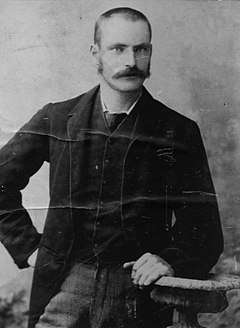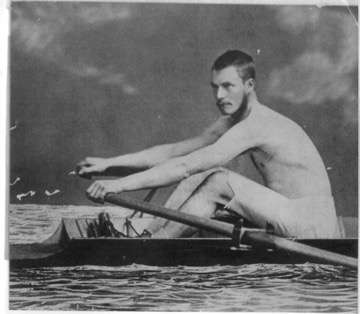Charles A. Messenger
Charles Amos Messenger, a professional sculler, was born in 1853[1] in London where his family was well known in aquatic circles. He married Annie Frances Atkinson on 30 November 1875 in Gore St Fitzroy, Victoria,[2] and died in Sydney on 21 April 1905.
 | |
| Personal information | |
|---|---|
| Ethnicity | British |
| Citizenship | Australian |
| Born | Teddington, England 1853 |
| Died | April 21, 1905 Double Bay, Sydney |
| Resting place | Waverley Cemetery, Clovelly NSW |
| Monuments | Tombstone (see photo) |
| Occupation | Professional Sculler and boatbuilder |
| Years active | 34 |
| Weight | 11 Stone |
| Spouse(s) | Annie Frances nee Atkinson |
| Sport | |
| Country | Australia |
| Sport | Rowing / Sculling |
| Achievements and titles | |
| Regional finals | Champion sculler of Victoria |
The couple had eight children including the original Australian superstar of Rugby League and Rugby Union, Dally Messenger. and the younger Wally Messenger, who also represented Australia in Rugby League.
Antecedent
His father James was a noted sculler and boat builder who in 1854 won the World Sculling Championship from Tom Cole (rower). James held the title for four years until beaten by the well known sculler Harry Kelley.
Charles' grandfather, James Arthur Messenger, was a Queen's waterman and bargemaster to Queen Victoria on the River Thames. In 1862 he won the sculling race down the Thames, the renowned and historical Doggett's Coat and Badge, the oldest rowing race in the world and which is mentioned in the famous diary of Samuel Pepys FRS 1633–1703. For centuries it was considered the sculling championship of the world.
Personal & Sculling chronology
Charles Messenger migrated to Australia in the early 1870s in search of sculling fame and fortune. He gained a job in his trade as a boatbuilder at Greenlands Boatbuilders in Melbourne, where boatsheds still exist to this day, east of Princes Bridge (2020).
At the time of his marriage (1875) he was living at Emerald Hill on the land on which is now the South Melbourne Town Hall.(2020).
His main competitors in Melbourne were John Christie and John Cazaly, father of the later famous Australian Rules footballer, Roy Cazaly, of Up There Cazaly fame. On July 1, 1878 it was John Christie whom Messenger defeated for the sculling championship of Victoria.
Even though, courtesy of the Gold Rush, Melbourne was the second largest city in the British Empire, word came to Charles that there was a rowing and sculling "fever" in NSW whereby races along the Parramatta River were enjoying over 100,000 spectators and the prize monies were much more generous than in Melbourne.
He grew his reputation. In a famous race against Elias Laycock, Messenger was dubbed the "Melbourne man" and his competitor the "Sydney man". When Messenger was clearly winning the race, supporters of Laycock, who were following the race in a ferry, crossed in front of Messenger and swamped him, thus ensuring the win for Laycock.
Despite this, Messenger returned to Melbourne, collected his wife and child (Bill) and shifted to Sydney. He set up a boatshed and boatbuilding business and a home at Balmain's Mort Bay where his second and third son (Charles Jnr and "Dally" (April 1883) were born.
Due to the intensity of Sydney development, in 1884 Messenger dismantled his business and home in Balmain and floated it in stages across to Double Bay. Here his business prospered as enthusiastic young people of Sydney took up sculling and sailing in boats mainly built by the Messengers.
All five Messenger sons, Bill, Charles, Dally, Ernie, and Wally, became apprentice boatbuilders to their father.
In an attempt to capitalise on the exuberance of a large following of boat enthusiasts, from May 1889 to Dec 1889, while retaining the Double Bay business, Charles Messenger became the licensee of Messenger's Tattersall's Hotel in Penrith on the Nepean River. It was here at Penrith that Messenger became part of the support team for another outstanding rower, Bill Beach, who successfully competed for the Championship of the world. He then returned to Double Bay.[3]
Sculling

His principal performances in Sydney were in a waterman's skiff race at the national regatta where he rowed third to Power (15 lbs) and Harry Pearce (55 lbs)[4]. In the third division of the Walker Whiskey race, he finished third to Michael Rush (rower) and R. Edwards. At the Grafton 1881 regatta, he started in the outrigger race against Rush and Elias C. Laycock, and was badly beaten.
In 1882 Messenger travelled to Auckland in New Zealand where he competed under the assumed name of ‘Carter.’ His trainer was Harry Floyd who was associated with many of the Sydney scullers. At the Mercury Bay regatta on 26 January 1882, Messenger beat A White in an outrigger race. A later match race between them for £100 a side had the same result as did another race at the Auckland Regatta. Later it was revealed who ‘Carter’ was. In March 1882 Messenger and William Hearn raced in Wellington for the Single Sculls Championship of New Zealand. See New Zealand Sculling Championship. The stake was £100 a side and Hearn won without any trouble. Messenger’s rowing weight was 11 stone (70 kg)
Strange Race

One of the strangest races ever recorded was that between Messenger and Bill Beach in March 1883 in the Anniversary regatta held in Sydney. Largan, the English sculler, was also in the race, but had his boat cut in two by a 14-ft. open sailing boat shortly before the start. He, however, started in a borrowed outrigger, but retired after going 200 yards.
The weather was very rough, and, after changing places repeatedly, Messenger, who was leading, had his boat burst open and swamped forward by a sea, the after part sticking up in the air about three feet. Beach who had broken his slide and was pulling on a fixed seat, then shot up to him and yelled out, "I've beaten you now." Messenger was, of course, inclined to give in, but the people on the steamer yelled at him to go on in hopes something would happen to Beach also. Sure enough they were right, for in a few minutes the stern of his boat sank and the bow cocked up at an angle of 45 degrees.
Then, Messenger seeing hope once more, removed his feet from the straps, took off his roller slides and held them in his mouth, and then standing up in his boat, half of which was completely buried under water, he turned round and sat straddle legs across the boat, his legs dangling in the water, a tempting bait for any shark in the vicinity. He faced the nose of the boat, and after an hour's hard rowing, during which the water was breaking over him, he rowed his boat stern first the last quarter of a mile, and passing the flagship a winner of one of the most singularly contested races ever recorded. After swamping, Beach gave up the contest.
References
- His tombstone (see photo) records that he was 52 when he died in 1905 and his Marriage Certificate no. 133 in 1875 in the District of Collingwood in the colony of Victoria, states that he was 22 years of age at the time of his marriage.
- Marriage Certificate no. 133 in 1875 in the District of Collingwood in the colony of Victoria.
- This section is almost entirely taken from Sean Fagan and Dally Messenger III, The Master, Hachette Livre, Sydney, 2007 pp1-10, ISBN 978 0 7336 2200 7
- This is presumed to be Harry Pearce father of Sandy Pearce
- Observer newspaper, Auckland, 10 Mar 1883, Wanganui Chronicle 6 July 1878, 14 Feb 1882
- Evening Post, 27 Mar 1882
- Edward Hanlan, Champion Sculler, published Melbourne Albert S Manders & Co 1884